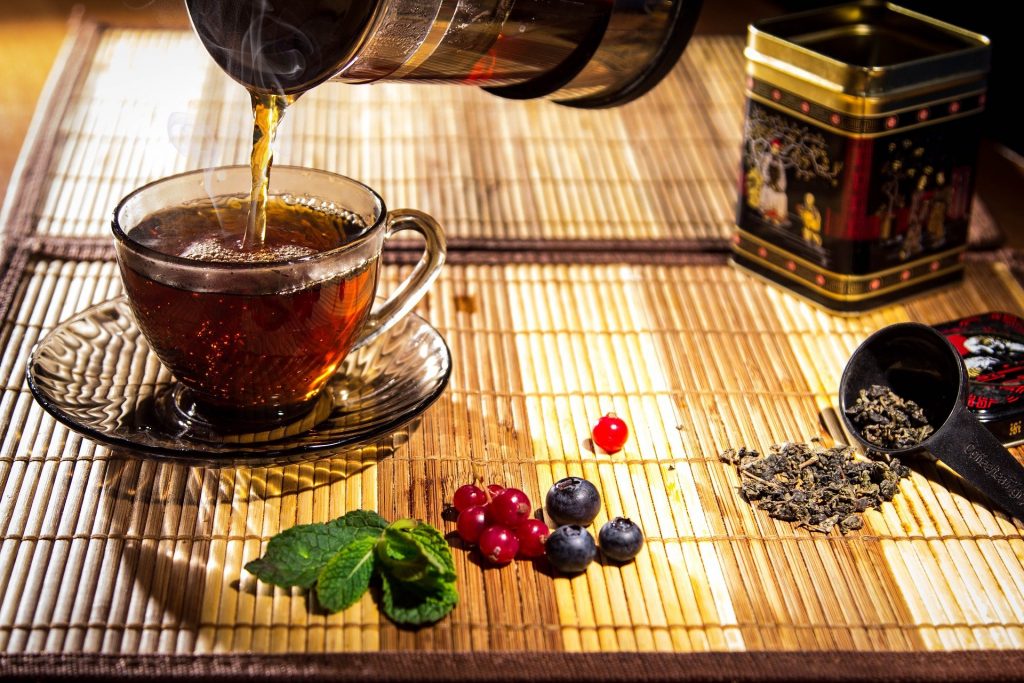[Article updated on 19/09/2023]
The different teas
Green tea and black tea are the 2 best-known and most consumed types of tea. These 2 teas come from the same plant. To differentiate them:
- Green tea: it is the most consumed tea in Asia. The tea leaves have just been dried. It is therefore the one that has the best nutritional benefit. Indeed, it is the one that contains the most polyphenols, anti-oxidants which fight against cellular aging. Its “vegetable” taste can be reminiscent of mowed grass.
- Black tea: it has undergone fermentation before being dried. This allows for better conservation and maintenance of taste even several years later. Its more bitter taste can be similar to that of coffee.
Other types of “teas” exist but be careful, this name is sometimes distorted because the drink results from the infusion of a plant which is not necessarily the tea plant.
- White tea or silver tea: it is made up of the buds of the plant, harvested in spring. It is a subtle and rare tea given the short harvest period. To keep its scent, it is better to use water at a low temperature.
- Oolong tea or blue tea: it is a semi-fermented tea, between green tea and black tea. It has a low theine content and has a mild taste. It is widely consumed in China and Taiwan.
- Rooibos or red tea: it comes from the plant of the same name and not the tea plant. It is grown mainly in South Africa. It is fermented and delivers a sweet taste without bitterness. In addition, its absence of theine allows it to be consumed at all ages, including by children.
- Green rooibos: this is unfermented rooibos.
All teas can be flavored either by using essential oils or natural or artificial flavors or by adding pieces of petals, dried fruit or spices. Thus, it is possible to make your own “homemade” flavored teas.
For commercial teas, it is better to favor those that use natural rather than artificial flavors.
The importance of good preparation
To appreciate all the quality and finesse of your tea, it is important to respect 3 points:
- the dosage: this is often indicated on your tea bag or box.
- the water temperature: 75-80°C for green tea, 85-90°C for black tea (or even 95°C for Darjeeling), 95°C for blue tea, 60°C for tea white, 100°C for rooibos and other infusions.
- infusion time: 3 minutes for green tea, 4 minutes for black tea and blue tea, 5 minutes for white tea, 5-10 minutes for rooibos and other infusions.
Beyond that, your drink risks developing an unpleasant bitterness in the mouth and you risk losing the subtlety of flavors.

Multitudes of benefits
Tea contains theophylline which has a vasodilatory action. It therefore allows better blood circulation.
It also contains theobromine which gives it its diuretic power.
These 2 benefits help combat feelings of heavy legs and water retention which can sometimes be unpleasant.
In addition, whether black, white or green, tea contains different antioxidants that fight against cellular aging.
Finally, you may have known about the tannins contained in red wine. Tea also contains it. These tannins allow reduce the risk of cardiovascular diseases.
Since tea is based on the principle of an infusion of leaves, it is better to buy it organic in order to avoid a significant diffusion of pesticides in your drink.
An ally for your hydration
Water is the main constituent of our body and we need at least 1L5/day (or more in the case of physical activity, extreme heat, etc.).
Consumed cold or hot, preferably without sugar, tea can be a real ally for your hydration.
Indeed, in winter, overheated rooms and heaters that dry out the air dehydrate us without us realizing it. We think less about drinking than in summer and water does not necessarily appeal to us… Tea can easily supplement this hydration, 2 mugs providing ½ L.
Trick : If you sweeten your tea, reduce your sugar intake by 1/2 sugar until you get used to the taste. Once you get used to it, reduce by 1/2 additional sugar. And so on until you completely eliminate sugar. You will thus get rid of the sweet taste, which will allow you to reduce your consumption of all other sweet products.
In summer, you can easily prepare your cold tea, a tasty and sugar-free alternative to sodas, sweetened flavored waters, etc. available commercially.
Cold tea recipe
- With a tea bag: infuse the bag in your cup and put it in the refrigerator for 1 hour to 1 hour 30 minutes.
- With loose leaf tea: Allow 2 teaspoons of tea and 2.5 hours of infusion time in the refrigerator for 500 mL of water.
Trick : you can use a milk bottle to have a neck big enough to pass the tea bag through and wedge it into the cork so you can easily remove the bag once it is brewed.
Be careful not to overuse it
- Even though it contains less than coffee, tea contains caffeine. From mid-afternoon, it is therefore better to favor infusions, rooibos, etc. Trick : As the caffeine in tea is released in the first seconds of infusion, you can simply reduce the caffeine content of your drink by discarding the infusion from the first steeping of your bag.
- The tannins in tea prevent the absorption of iron. If you tend to be anemic, it is better to limit your consumption close to meals.
- Be careful not to give in to the temptation of multiple nutritional supplements based on green tea, ANSES prefers to be vigilant about these products which can present a risk of toxicity!
